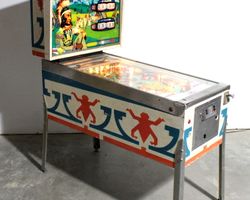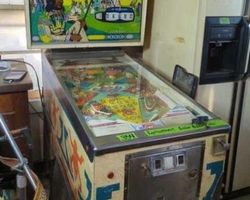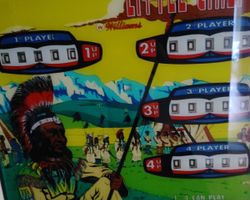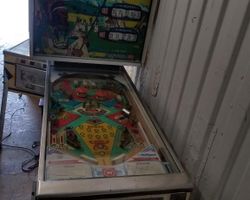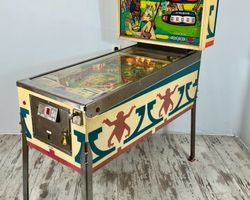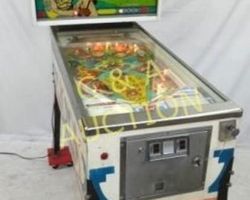Little Chief
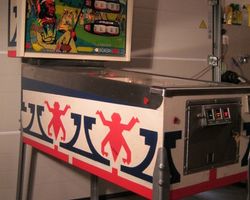
Average Prices: USD $200 to $600
Produced: September, 1975
Production Run: 6,300 units
Machine Type: Electro-mechanical
Players: 4
Design by: Steve Kordek
Art by: Christian Marche
"Little Chief," released by Williams Electronics, Inc. in September 1975, represents a distinct chapter in the electro-mechanical (EM) era of pinball. With a production run of 6,300 units, this machine offered a four-player experience designed to capture the attention of a wide audience. The creative force behind Little Chief was Steve Kordek, who not only conceived the game's core concept but also meticulously handled its design and mechanical engineering. Christian Marche contributed the distinct artistic vision, crafting the machine's visual identity. The collaboration resulted in a pinball experience steeped in a Western, American West theme, offering a unique aesthetic for its time. A curious detail from the era's promotional materials, the manufacturer's flyer contained a grammatically muddled description: "Little Chief is a superb action game with exciting skill shots, astonishing rebound ball action and balanced top to the bottom of the playfield appear." Despite such minor communication quirks, the machine itself aimed for clarity in its gameplay.
Distinctive Characteristics
The visual appeal of Little Chief is primarily defined by Christian Marche’s artwork. The playfield and backglass feature a subdued palette, evoking a peaceful plains mountain valley scene, often interpreted as an old Native American camp. This artistic choice provides a calming backdrop, a contrast to the often vibrant and chaotic designs common in pinball. While opinions on the theme itself vary—some find its depiction of Native Americans fittingly non-caricatured for the era, while others feel it has not aged well—the artistry is consistently noted for its unique quality and unusual colors.
Beyond the visuals, Little Chief’s mechanical features are typical of a mid-1970s EM machine, yet it presents them in a way that contributes to its specific gameplay rhythm. It features two flippers for player control, two pop bumpers, and two slingshots that provide kinetic action. A single standup target and a kick-out hole are key interactive elements. A mid-field ball return gate allows for strategic playfield navigation. Sound is delivered through a trio of chimes and a knocker, providing satisfying auditory feedback for points and major awards. A standout mechanical element is the central kick-out hole, which engages a stepper unit to increment a central value. This unit is vital for increasing scores and triggering awards.
Playfield Architecture and Engagement
The playfield of Little Chief is characterized by an asymmetric layout that influences ball flow and shot opportunities. A wide left orbit provides a significant path for the ball, while a gate shot strategically returns the ball to the low right side of the playfield. The central saucer or kick-out hole is a pivotal element, its placement allowing for critical bonus multiplier opportunities. The primary scoring objectives revolve around activating the A and B rollovers, or the left and right inlanes, which open the crucial mid-field gate.
The design philosophy prioritizes a bonus-centric scoring system. Players are encouraged to build their bonus by hitting various targets and rollovers before collecting it. The artwork, as previously mentioned, creates an immersive visual environment, with detailed depictions of Southwestern elements and serene landscapes that transport the player into its theme. While some players desire brighter playfield illumination, the existing lighting contributes to the machine's overall vintage aesthetic. The physical layout, with only two upper bumpers and limited slings, gives Little Chief a less "kinetic" feel than some of its contemporaries, meaning ball action can be more predictable rather than wild. The kick-out hole's positioning further limits rampant bumper activity. The bonus collection mechanism, which often involves a precise shot to the center saucer/rollover followed by a return-to-plunger sequence, is considered a particularly well-executed aspect of the game's mechanical design.
Gameplay Strategy and Flow
The gameplay mechanics of Little Chief are rooted in a clear, bonus-driven progression. The primary objective is to build the end-of-ball bonus by hitting targets and rollovers, then strategically double it via the central saucer before the ball drains. Successfully collecting the bonus via the center saucer/rollover and the subsequent return shot is a core challenge, resetting the sequence and making each bonus accumulation critical for high scores.
Little Chief distinguishes itself with unique awards tied to the central kick-out hole. As the ball enters this hole, a stepper unit increments a central value. Reaching specific values triggers "Special" awards, which grant an extra ball, and "Extra Special" awards, which provide a credit. This distinction between extra balls and credits, using the unique "Special" and "Extra Special" nomenclature, adds a layer of objective for players.
The machine is often described as easy to understand but difficult to master, making it approachable for novice players while offering depth for those seeking a challenge. Strategic play involves navigating the asymmetric layout, carefully aiming for the central saucer to maximize bonus, and managing the ball's trajectory after kick-outs. Some aspects, like the "mean" side drains with low-placed return lanes and the potential for the kick-out unit to send the ball directly down the center, add elements of high risk to gameplay. The saucer/post setup can also lead to unpredictable, dangerous ball flows, requiring players to react quickly. However, the availability of "Special" and "Extra Special" awards offers a degree of forgiveness, allowing players to extend their game and pursue higher scores. The overall difficulty can vary considerably based on how the machine is tuned, affecting everything from flipper strength to rubber bounciness.
Community Insights and Lasting Impact
The pinball community holds a mixed-to-positive sentiment towards Little Chief, with an average rating around 7.3. Many players find it to be an engaging EM game, particularly suitable as an entry-level machine or for casual play. Its strengths are frequently cited as its solid layout, the unique and satisfying bonus collection mechanism, and its general accessibility. The artwork, for many, remains a highlight, appreciated for its distinctive aesthetic that stands apart from typical pinball art.
However, Little Chief is not without its criticisms. As a four-player EM machine, it presents maintenance challenges inherent to its era's technology, particularly regarding the "eject unit" associated with the central kick-out hole. Some players find the gameplay loop to be somewhat shallow or repetitive over extended sessions. Specific mechanical drawbacks include the unforgiving outlanes and the occasional unpredictable trajectory of the ball from the kick-out unit. The theme's relevance and appeal are a notable point of contention; while some appreciate the subdued artistic depiction, others find it dated or lacking direct integration with the gameplay.
Despite these criticisms, Little Chief maintains a respectable reputation within the pinball community. It is often recommended as a "must-try" for enthusiasts of EM machines, showcasing Steve Kordek's design prowess in creating a bonus-centric game that is both approachable and strategically rewarding. Its legacy lies in its ability to deliver a satisfying pinball experience within the constraints of mid-70s EM technology, serving as an example of how effective simple, yet clever, rule sets can be. It continues to be a worthwhile addition to home collections, representing a specific historical period of pinball design and art.
Sponsored Links
 Ebay Listings
Ebay Listings
 Auction Results
Auction Results
| Cost | Location | Date |
|---|---|---|
| USD $1,300 |  Michigan, United States Michigan, United States |
19 September, 2025 |
| USD $400 |  Illinois, United States Illinois, United States |
16 May, 2025 |
| EUR €525 |  Nordrhein-Westfalen, Germany Nordrhein-Westfalen, Germany |
06 April, 2025 |
| EUR €662 |  Nordrhein-Westfalen, Germany Nordrhein-Westfalen, Germany |
23 March, 2025 |
| USD $1,250 |  Canada Canada |
20 February, 2024 |
| AUD $1,000 |  New South Wales, Australia New South Wales, Australia |
10 December, 2023 |
| USD $650 |  Maryland, United States Maryland, United States |
07 December, 2023 |
| EUR €395 |  Niedersachsen, Germany Niedersachsen, Germany |
16 November, 2023 |
| EUR €565 |  Hessen, Germany Hessen, Germany |
31 August, 2023 |
| EUR €595 |  Hessen, Germany Hessen, Germany |
20 August, 2023 |


Private Policy · Search Website · Contact Us
As an eBay Partner, we may earn a commission from qualifying purchases made through links on this site, at no additional cost to you.
All trademarks and copyrighted materials remain property of their respective owners. All other content copyright 2007 - 2025 Pinpedia.

